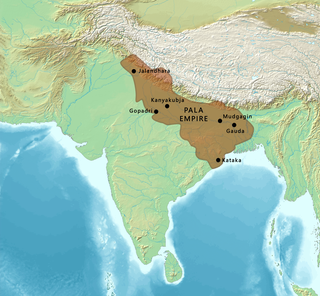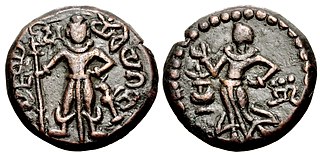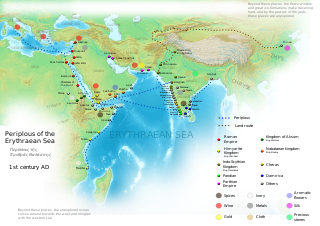Related Research Articles

Balarama is a Hindu god, and the elder brother of Krishna. He is particularly significant in the Jagannath tradition, as one of the triad deities. He is also known as Haladhara, Halayudha, Baladeva, Balabhadra, and Sankarshana.

Chandragupta Maurya was the founder of the Maurya Empire, based in Magadha. His rise to power began after the death of Alexander in 323 BCE, when at ca. 317 BCE he raised an army to resist the Greeks following a period of unrest and local warfare, defeating them and annexing Greek territory in the eastern Indus Valley. After insulting the Nanda king and ordered to be executed, he started a war against the unpopular Nanda dynasty, defeating them and establishing his own dynasty, "widely, and casually" dated at ca. 322-319 BCE, or "between c.311 and c.305 bc." According to Buddhist and Jain legends, he did this with help of his mentor Chanakya who later became his minister. He expanded his reach beyond the Ganges Valley into parts of the western Indus Valley and possibly eastern Afghanistan through a dynastic marriage alliance with Seleucus I Nicator in ca. 305-303 BCE, exploiting the power-vacuum that arose after Alexander's Indian campaign and his early death. His empire also included Gujarat, controlling a geographically extensive network of cities and trade-routes.

Kapila Vatsyayan was a leading scholar of Indian classical dance, art, architecture, and art history. She served as a member of parliament and bureaucrat in India, and also served as the founding director of the Indira Gandhi National Centre for the Arts.

The Kanva dynasty or Kanvavamsha was a ruling dynasty of Magadha, established after Vasudeva Kanva overthrew the preceding Shunga dynasty and ruled from 73 BCE to 28 BCE.

Kalinga is a historical region of India. It is generally defined as the eastern coastal region between the Ganges and the Godavari rivers, although its boundaries have fluctuated with the territory of its rulers. The core territory of Kalinga now encompasses all of Odisha and some part of northern Andhra Pradesh. At its widest extent, the Kalinga region also included parts of present-day Chhattisgarh, extending up to Amarkantak in the west. In the ancient period it extended until the bank of the Ganges river.

Dasharatha Maurya was the 4th Mauryan emperor from 232 to 224 BCE. He was a grandson of Ashoka the Great and is commonly held to have succeeded him as the Emperor of Magadha. Dasharatha presided over a declining imperium and several territories of the empire broke away from central rule during his reign. He had continued the religious and social policies of Ashoka. Dasharatha was the last Mauryan emperor to have issued imperial inscriptions—thus the last Mauryan emperor to be known from epigraphical sources.

The Pāla Empire was an imperial power during the post-classical period in the Indian subcontinent, which originated in the region of Bengal. It is named after its ruling dynasty, whose rulers bore names ending with the suffix Pāla. The empire was founded with the election of Gopāla as the emperor of Gauda in late eighth century CE. The Pala stronghold was located in Bengal and eastern Bihar, which included the major cities of Gauḍa, Vikramapura, Pāṭaliputra, Monghyr, Somapura, Ramavati (Varendra), Tāmralipta and Jagaddala.

The Coinage of India began anywhere between early 1st millennium BCE to the 6th century BCE, and consisted mainly of copper and silver coins in its initial stage. The coins of this period were Karshapanas or Pana. A variety of earliest Indian coins, however, unlike those circulated in West Asia, were stamped bars of metal, suggesting that the innovation of stamped currency was added to a pre-existing form of token currency which had already been present in the Janapadas and Mahajanapada kingdoms of the Early historic India. The kingdoms that minted their own coins included Gandhara, Kuntala, Kuru, Magadha, Panchala, Shakya, Surasena, Surashtra and Vidarbha etc.

Samprati was the 5th Emperor of the Maurya Empire. He was the grandson of 3rd Mauryan Emperor Ashoka and the son of Kunala.He succeeded his cousin, 4th Mauryan Emperor Dasharatha, as emperor of the Maurya Empire. According to Jain tradition he built 1,50,000 Jain derasars and made 1,50,00,000 Jain idols. He was also believed to have taken an oath to dig the foundation of a new Jinalaya every day and would not do navakrashi (breakfast) until it was completed.

The Kalinga war was fought in ancient India between the Mauryan Empire under Ashoka the Great and Kalinga, an independent feudal kingdom located on the east coast, in the present-day state of Odisha and northern parts of Andhra Pradesh. It is presumed that the battle was fought on Dhauli hills in Dhauli which is situated on the banks of Daya River. The Kalinga War was one of the largest and deadliest battles in Indian history.
Indraprastha is a mythological city cited in ancient Indian literature as a constituent of the Kuru Kingdom. It was designated the capital of the Pandavas, a brotherly quintet in the Hindu epic Mahabharata. Under the Pali form of its name, Indapatta, it is also broached upon in Buddhist texts as the capital of the Kuru Mahajanapada. The topography of the medieval fort Purana Qila on the banks of the river Yamuna matches the literary description of the citadel Indraprastha in the Mahabharata; however, excavations in the area have revealed no signs of an ancient built environment. The mythical city is sometimes also referred to as Khandavaprastha or Khandava Forest, the epithet of a forested region situated on the banks of Yamuna river which, going by the Hindu epic Mahabharata, was cleared by Krishna and Arjuna to build the city.

Panchala was an ancient kingdom of northern India, located in the Ganges-Yamuna Doab of the Upper Gangetic plain which is identified as Kanyakubja or region around Kannauj. During Late Vedic times, it was one of the most powerful states of ancient India, closely allied with the Kuru Kingdom. By the c. 5th century BCE, it had become an oligarchic confederacy, considered one of the solasa (sixteen) mahajanapadas of the Indian subcontinent. After being absorbed into the Mauryan Empire, Panchala regained its independence until it was annexed by the Gupta Empire in the 4th century CE.

Yaudheya (Brahmi script: 𑀬𑁅𑀥𑁂𑀬) or Yoddheya Gana (Yoddheya Republic) was an ancient military ganasangha (republic) based in the Eastern region of the Sapta Sindhu. The word Yaudheya is a derivative of the word from yodha meaning warriors and according to Pāṇini, the suffix '-ya', was significant of warrior tribes, which is supported by their resistance to invading empires such as the Kushan Empire and the Indo-Scythians. Rudradaman I of the Western Satraps notes in his Junagadh rock inscription that the Yaudheyas were 'heroes among all Kshatriya' and 'were loath to surrender'. They were noted as having a republic form of government, unique from other Janapadas which instead maintained monarchies.
Bhāsa is one of the earliest Indian playwrights in Sanskrit, predating Kālidasa. Estimates of his floruit range from the 4th century BCE to the 4th century CE; the thirteen plays attributed to him are commonly dated closer to the first or second century CE.
Gopala was the founder of the Pala dynasty, which was based in the Bengal region of the Indian subcontinent. The last morpheme of his name Pala means "protector" and was used as an ending for the names of all the Pala monarchs. Pala does not suggest or indicate any ethnic or caste considerations of the Pala dynasty. He came to power in later half of eighth century AD in Gaur/Gaud after being elected by a group of regional chieftains.
The Mudrārākshasa is a Sanskrit-language play by Vishakhadatta that narrates the ascent of the Emperor Chandragupta Maurya to power in India. The play is an example of creative writing, but not entirely fictional. It is dated variously from the late 4th century to the 8th century CE.

An uttariya is a loose piece of upper body clothing with its origins in ancient India. It is a single piece of cloth that falls from the back of the neck to curl around both arms and could also drape the top half of the body. An uttariya is similar to a veil, a long scarf and shawl. The Vedas describe the garment to comprise various loose cloths worn for upper body such as upavasana, parayanahana and adhivasa, varhatika and varnaka, uttarsanghasamvyana.
Śārṅgadeva (1175–1247), also spelled Sharngadeva or Sarnga Deva, was a 13th-century Indian musicologist who authored Sangita Ratnakara – a Sanskrit text on music and drama. It is considered to be the authoritative treatise on Indian classical music by both the Hindustani and Carnatic music traditions.

Sarapion was an ancient port city located in the Horn of Africa.
Mitra dynasty of Kosambi was centered on the city of Kosambi at the Vatsa region. Its capital Kosambi was among the most important trade centers in the ancient India. The dynasty also likely controlled territory in nearby regions such as Magadha.
References
- ↑ Singh, Upinder (2008). A History of Ancient and Early Medieval India: From the Stone Age to the 12th Century. Pearson Education India. ISBN 978-81-317-1677-9.
- ↑ Sathe, Shriram (1987). Dates of the Buddha. Bharatiya Itihasa Sankalana Samiti.
- ↑ SHARMA, J. P. (1968). REPUBLICS IN ANCIENT INDIA c. 1500 B.C.- 500 B.C. pp. 182–206.
- ↑ Raychaudhuri, Hemchandra (2006). Political History of Ancient India: From the Accession of Parikshit to the Extinction of the Gupta Dynasty. Cosmo Publications. ISBN 978-81-307-0291-9.
- ↑ Ganguly, Dilip Kumar (1984). History and historians in ancient India. Internet Archive. New Delhi : Abhinav Publications. pp. 19–20.
- ↑ Journal of the Buddhist Text Society of India. The Society. 1895. pp. 26–32.
- ↑ Chandragupta Maurya and his times pg.6-8 31-33
- ↑ Age of Nanadas and Mauryas Pg.18
- ↑ Thapar Romila (1966). Ancient India A Textbook Of History For Middle Schools. Ncert.
- ↑ Chandra, Moti. Trade And Trade Routes In Ancient India. Abhinav Publications. p. 75. ISBN 978-81-7017-055-6.
- ↑ Sen, Sailendra Nath (1999). Ancient Indian History and Civilization. New Age International. p. 170. ISBN 978-81-224-1198-0.
- ↑ Bajpai, K. D. (October 2004). Indian Numismatic Studies. Abhinav Publications. pp. 38–39. ISBN 978-81-7017-035-8.